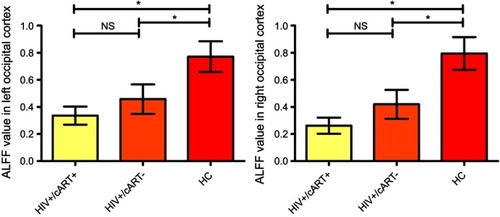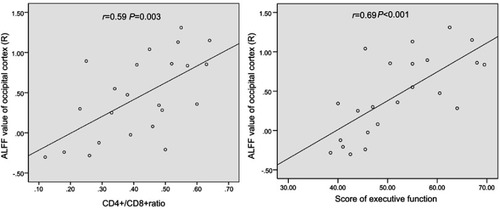Figures & data
Table 1 Neurocognitive scales and corresponding cognitive domains
Table 2 Demographic, clinical, and neruopsychological data of the three groups
Table 3 Regions showing ALFF differences among cART+, cART–, and healthy control subject groups
Figure 1 ALFF maps show the differences among HIV+/cART+, HIV+/cART–, and HC groups. F test revealed significant differences located in bilateral occipital lobes. In comparison with HC, patients in HIV+/cART+ group showed significantly lower ALFF values in bilateral occipital lobes and higher ALFF values mainly in the right frontoparietal lobe and caudate; individuals in HIV+/cART– group showed significantly lower ALFF values in the right occipital lobe and higher ALFF values in bilateral caudate. Compared with HIV+/cART–, HIV+/cART+ showed significantly higher ALFF in right superior temporal gyrus and supramarginal gyrus.

Figure 2 The differences in altered ALFF values in bilateral occipital lobes among HIV+/cART+, HIV+/cART–, and HC groups. Bar graph showed the normalized ALFF values in the occipital cortex. Significantly decreased ALFF values are found in HIV+/cART+ and HIV+/cART– groups compared with HC, respectively. HIV+/cART+ group was lower than that of the HIV+/cART– group, but the difference was not statistically significant.
Abbreviations: NS, nonsignificant; ALFF, amplitude of low-frequency fluctuation; HIV+/cART+, HIV patients experiencing stable cART; HIV+/cART–, treatment-naïve HIV individuals; HC, healthy controls.

Figure 3 Relationship between ALFF values and clinical variables and cognitive performances in HIV patients. Normalized ALFF values of the right occipital cortex positively correlated with CD4+/CD8+ ratio and executive function in HIV+/cART.

